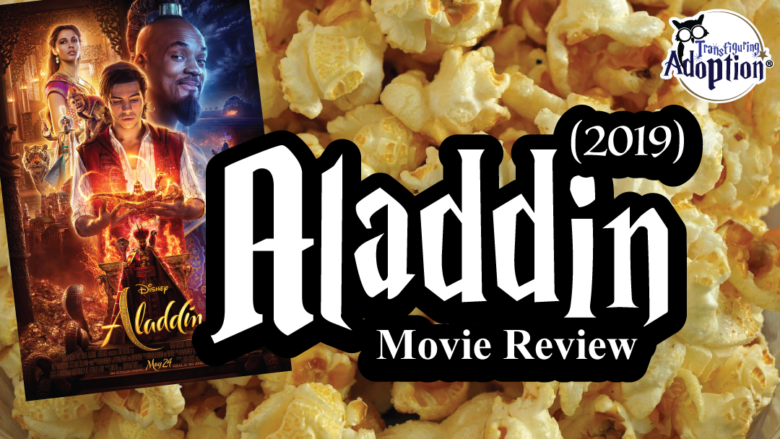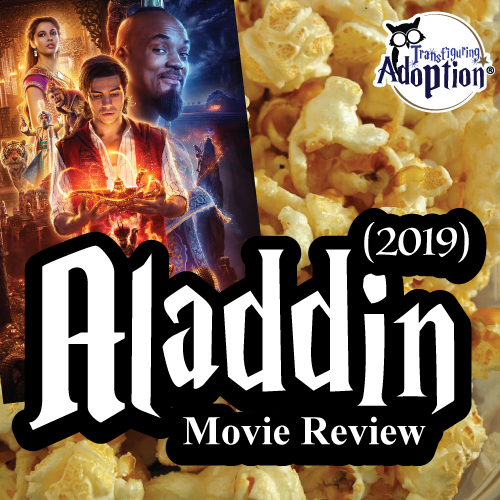Grade:
Transfiguring Adoption awarded this movie 4 Hoots out of 5 based on how useful it will be for a foster/adoptive family. [Learn more about our Hoot grading system here]
Movie Info:
From the Cover of Aladdin by Disney:
“Aladdin is a lovable street urchin who meets Princess Jasmine, the beautiful daughter of the sultan of Agrabah. While visiting her exotic palace, Aladdin stumbles upon a magic oil lamp that unleashes a powerful, wisecracking, larger-than-life genie. As Aladdin and the genie start to become friends, they must soon embark on a dangerous mission to stop the evil sorcerer Jafar from overthrowing young Jasmine’s kingdom.”
If you’ve been on the Internet at all within the last 6 months, you’ve probably seen news articles or people in your Facebook feed complaining about the new remake of Aladdin. Many people are of the belief that Disney should leave well enough alone and stop remaking all of the old cartoons into new live action movies. While I personally never had a preference and love to throw my money at Disney, I went into the new movie with an open mind and the reminder to not compare the new genie to the old genie (RIP Robin Williams).
I immediately forgot all about the 1992 classic when I got into the new style of songs, clothing, and changes in the storyline. Although the movie is right over two hours long, it felt like a really short time because I was having so much fun dancing in my seat to the music and laughing at all of the new antics Aladdin, Abu, Jasmine, and Genie got themselves into. This live action remake is my favorite so far of all the classic remakes. The storyline changed slightly enough to make it more mainstream, but lovers of the original will be able to enjoy some of their favorite scenes.
** Spoilers Could Be Ahead **
How Is This Relevant To Adoption & Foster Care?
Aladdin is a young man living on the streets of Agrabah. He has no family or friends besides his monkey/sidekick Abu. He is very poor and survives by stealing food and sleeping on an abandoned rooftop that he attempts to make feel like home using torn curtains and old pillows. Many of our kids are able to connect with Aladdin due to being able to see themselves in Aladdin’s shoes, especially our older kids who spent time in foster care. It is not unheard of that our children have stolen in order to have something to eat or that they spent time living in less than desirable living conditions.
Jasmine, the princess of Agrabah, sees starving children and wants to give them an apple. She doesn’t understand the concept of the people in the market allowing the children to go hungry when there are plentiful amounts of food in order to share. If your child is lucky and never experienced hunger, they may not be able to associate this scene with their life, but the reality is many children will see themselves as those hungry orphan kids in the marketplace. This can cause some upsetting memories to return.
Aladdin, desperately wanting a family to call his own, completely changes who he is in order to marry Jasmine. The actor who played Aladdin describes him perfectly when explaining who Aladdin is by saying he “sees a future for himself that’s greater than what’s been set out for him at the present moment. He doesn’t know exactly what it is or how he’s going to get there, but he knows it is out there.” I think this is the single most powerful thing to take away from the movie is realizing that many of our kids had to go to great lengths to get what they want, a family. Some of them may have felt that they needed to change who they were to be adopted or others felt they needed to change to fit in more with their biological, foster, or adoptive family. Regardless of where your child fits on this spectrum, it’s important to validate those fears and reinforce the idea that they are loved and treasured for who they truly are.
Discussion Points:
- Aladdin’s situation might hit a little close to home.
Feeling alone and not having a family, a home, or a support system can be really upsetting to our kids. This allows a discussion to be had about how they felt when living in a similar way to Aladdin, either through group homes or with their biological parents. If the children were adopted as infants, this can be a really empathetic way to help them understand what some of their peers experienced before they found their forever family. - Despite the challenges that Aladdin and Jasmine face, they are able to get their happily ever after.
Not only does Aladdin have to prove himself worthy of Jasmine without becoming a prince, Jasmine has to break the mold of becoming the first female sultan of Agrabah. This was definitely not accomplished without some hiccups, mainly with Jafar. There will always be a villain in our kids’ lives who is trying to stop them from their “happily ever after.” This might be a case manager, a biological parent, an adoptive parent, or some other random person whom we would never expect to be casted as the evil villain. Our kids brains have an interesting way of making sense of things when they don’t understand, and sometimes that information may get a little skewed. It’s understandable that you may want to set things straight with them, but it’s best to do it when they are emotionally ready and mature enough to understand what really happened. - Honesty wins.
One of the things that I appreciated about this new version compared to the old version is that Aladdin isn’t lying to Princess Jasmine throughout the entire movie and then magically forgiven at the end. This may have made for appropriate movie magic back in the 90’s, but it’s not generally accepted in children’s movies in present day. Jasmine had a much more powerful role in this film and was able to accomplish things that many women today are allowed to do. - Mental health sensitivity.
I also felt that this movie is a lot more sensitive to mental health. In the 1992 version, Aladdin explains Jasmine’s misunderstanding of taking an apple without paying on her being “crazy.” This version doesn’t blame anyone’s poor choices on mental health, which I believe will continue to foster a more positive viewpoint towards mental health conditions.
Cautionary Points:
- Aladdin was kidnapped and taken to the dessert in order to enter the Cave of Wonders.
Hopefully your children were never kidnapped, but being removed from the only family you have ever known and being placed with strangers can certainly feel like kidnapping at times. If your child experienced a removal, this might be a bit triggering for them. - Aladdin was abandoned in the Cave of Wonders.
When Aladdin does not successfully complete the task he was chosen for, despite it not being his fault, the cave traps him, and the people that brought him there abandon him, leaving him to die. Many of our children have experienced the emotions of abandonment and seeing it play out on the screen in this manner can cause them to relive those emotions. It’s important that as parents we are sensitive to these emotions.
Buy From Our Links and Support Transfiguring Adoption:
Transfiguring Adoption is a nonprofit organization seeking to nurture growth in foster and adoptive families by giving a HOOT about their families. Transfiguring Adoption does not intend for its reviewers nor its review to be professional, medical or legal advice. These reviews and discussion guides are intended to help parents to better be able to connect and understand their children who come from traumatic backgrounds.


